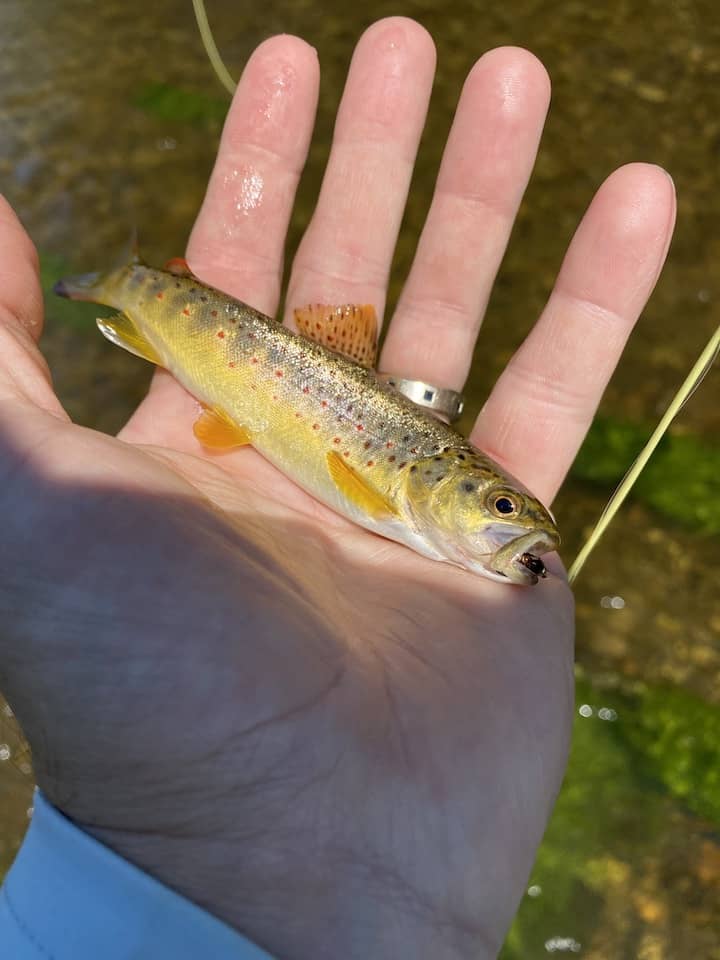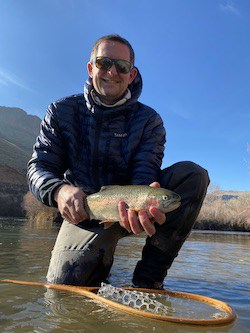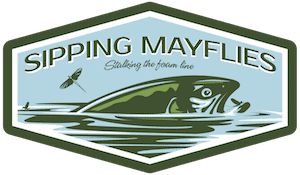Pictures of Wild Brown Trout with Red Spots
May 1st, 2022
When you hook into a brown trout (Salmo trutta), you never know what its colors or pattern will be because they’re both determined by several factors, including the fish’s genetics and environment.
I’ve caught countless brown trout and will show you pictures and videos of the various colors, and the story behind each strain (German vs non-German). Some brown trout have no red spots at all, and some actually have red spots with blue halos.
Here’s a picture I took a few days ago of a large brown trout with red and black dots, but the dots are quite sparsely spaced.

Brown Trout with Red Spots
Most folks think red spots on a brown trout (Salmo trutta) are the most attractive pattern you can find in a river fish. While this is debatable (brook trout can be stunning), it’s a classic color and pattern combination that never gets old if you’re an angler.
Red spots are generally associated with the german strains of brown trout. Fertilized eggs from these highly sought-after gamefish were brought to America from Germany in the mid-1860’s. The eggs were hatched in New York and the fry were dispersed into local rivers.
This egg importation process continued well into the 1890’s.
Today, brown trout can be found in nearby every state in the U.S., with the exception of Florida and Mississippi. Yes, there are brown trout in Hawaii (Kauai, specifically).
Here’s a picture of a german brown trout with red spots, a fish I caught late last year on a dry fly in a nearby river. Notice the red coloration on the adipose fin too.

li iBrown Trout with No Red Spots
Brown trout don’t always have red spots. In fact, I catch many don’t have any red coloration whatsoever.
It’s widely believed that American brown trout lacking red spots are descendants of fish that originated from Scotland and Ireland.
While it’s true that the Scottish and Irish brown trout had no red spots, it’s also widely believed that there are other reasons these fish can lack reddish spots.
Farmed vs Wild Brown Trout Colors
Farm-raised brown trout are generally less colorful than their wild counterparts. No one knows exactly why, but it’s been claimed that these farmed fish will often gain red spots after a period of time living in natural rivers, streams, or creeks.
“Farmed” is another word for trout that hatched from eggs in a public or private hatchery. Many U.S. states farm their own brown trout and release them into rivers and streams for the benefit of those who like to fish.
It’s a good return on investment for the states because fishing license revenue is a large part of their Fish and Wildlife (or DNR) budget.
River vs Lake Brown Trout Colors
It’s common knowledge that brown trout in darker water will have fewer red spots. I’ve witnessed this myself in the various rivers I fish. So, there’s some adaptation at work.
Some browns develop blue halos are their red spots, but we don’t yet understand why. It’s not attributed to a specific strain.
Here’s something fascinating: if a brown trout is taken from a river and placed into a lake, it’ll eventually lose it’s red spots.
I caught this fat brown trout with no red spots or coloration at all in a river with darker water, sometimes called “frogwater.” It’s likely a descendant of the Scottish or Irish strains.

Brown Trout Strains
Here’s a list of several brown trout (Salmo trutta) strains that you’ll find in the United States:
German – These have red spots and are common across the U.S.
Seeforellen – This strain is also german, but has a smaller range than the classic “german” brown trout.
Bachforelle – Yet another strain from germany, where
Lock Leven – These browns are scottish in origin and have very few, if any, red spots. They have a more silver base color, instead of golden. Their range is quite large across America.
Gillaroos – One of two strains of brown trout from Ireland, these fish have considerable black speckling.
Sonaghen – Another irish brown trout, this strain has bluish coloration with fewer speckles.
Why do Brown Trout Turn Red?
Brown trout gain red coloration during their spawning season which generally runs from late October to late December in the U.S., with timing varying slightly across their range due to climate.
Ironically, the gravel depression that brown trout lay their eggs in is called a “redd.”
Here’s a picture of a wild (not farmed) baby brown trout I caught on a pheasant tail nymph in late fall. Notice the beautiful coloration and spots, even as a juvenile.

Summary
Brown trout are definitely one of the most beautiful (and sought-after) fish in American rivers today. Their red spots are unmistakable when compared to their cousins: rainbow, brook, bull, lake, and cutthroat trout.
If your local fishing waters are stocked with hatchery trout, they likely won’t be as colorful as their wild cousins. So, if you’re chasing color, focus on rivers and lakes where stocking doesn’t take place. This information can be found on your state’s Fish and Wildlife (or DNR) website.
If you’d like to learn more about how to catch these beautiful fish, check out my article about fly fishing for brown trout.

About the Author
My name's Sam and I'm a fly fishing enthusiast just like you. I get out onto the water 80+ times each year, whether it's blazing hot or snow is falling. I enjoy chasing everything from brown trout to snook, and exploring new waters is something I savor. My goal is to discover something new each time I hit the water. Along those lines, I record everything I learn in my fly fishing journal so I can share it with you.
Follow me on Instagram , YouTube, and Facebook to see pictures and videos of my catches and other fishing adventures!


